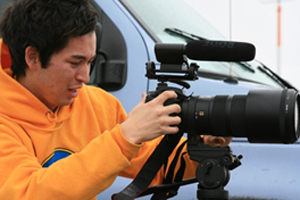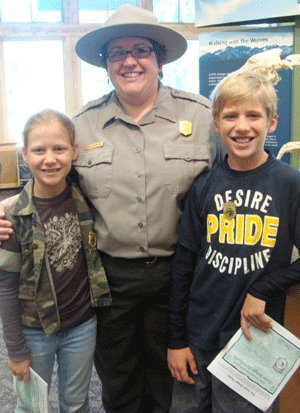The Murie Science and Learning Center (MSLC) funds numerous outreach projects through the Science Education Microgrant program. The microgrants help MSLC partner parks pay for science education outreach projects. Funding for the microgrants is provided by Alaska Geographic.
Transforming Deadman Slough Debris: Fostering Stewardship through Art and Science

NPS Photo / Melanie Flamme
Project Coordinators: Melanie Flamme (NPS - Yukon Charley and Gates of the Arctic), Stacia Backensto (NPS - Arctic Inventory and Monitoring Network)
Students at Effie Kokrine Early College Charter School partnered with the NPS, Center for Alaskan Coastal Studies (CACS), Mocha Dan’s Coffee Stand, Jon’s Machine Shop and artists, Mercedes Culliton and Craig Cheledinas, to restore neighboring Deadman Slough in Fairbanks, Alaska. The entire student body (167) picked up trash last spring along the Slough and neighboring Peirce Park. Through workshops conducted by CACS last September, students learned about the impacts of refuse accumulation in the environment and how to create beautiful, large-scale awareness-art sculptures from the repurposed trash. Working with the artists and NPS, the students are constructing a larger-than-life-sized black bear made of aluminum cans and a six-foot-tall ptarmigan made of milk jugs. Mocha Dan’s donated recyclables and the Machine Shop created the bear armature. The trash art sculptures will be placed in Peirce Park in spring of 2014 to raise public awareness about the impacts of trash on the environment.
Engaging Students in Alaska Park Science and Species Stewardship Through Videography

NPS Photo
Project Coordinator: Melanie Flamme, Yukon Charley and Gates of the Arctic Stacia Backensto, Arctic Inventory and Monitoring Network
18 year-old Max Dan of Anchorage and 14 year-old Sam Tocktoo of Shishmaref travelled to Bering Land Bridge National Preserve last June to film NPS monitoring activities for yellow-billed loons. Both students were part of a collaborative project with NPS, Alaska Geographic, Wildlife Conservation Society, and Alaska Teen Media Institute (ATMI) focused on engaging youth in long-term monitoring efforts of yellow-billed loons (an ARCN vital sign) in BELA through video storytelling. Unfortunately, the late thaw of lakes on the Seward Peninsula and poor weather in Kotzebue hampered the pair’s videography efforts. Despite these limitations, the pair produced a story in just four days at ATMI using footage Max collected in Kotzebue and from a Cessna 206. We plan to expand this project to include youth from Savoonga and the North Slope– other areas important to yellow-billed loons and their conservation.
Watch Max and Sam's video.
Capturing Natural Resource Work in Arction
Project Coordinator: Brooke Carney, Alaska Inventory and Monitoring Program
Every season of the year, National Park Service (NPS) scientists quietly go about taking measurements that tell us the condition of natural resources in your national parks. This project aims to bring their work, which is often off the beaten path, to NPS employees, partners, and visitors via photography and video. With the MSLC micro-grant, we are purchasing camera lenses, a new tripod, and an audio recorder that will enhance the quality of footage we are able to capture. This summer, we will join scientists in Wrangell-St. Elias as they conduct annual sampling for the Central Alaska Network's Rivers and Streams monitoring program. At the end of the summer, we'll share a video summary of the project with the public. In addition, we'll share photos, video footage, and audio interviews with NPS interpretation staff so that they can continue to "tell the story" of science in the parks through their own programs.
Curriculum Development for Bering Land Bridge National Preserve
Project Coordinator: Jennifer Thelen, Bering Land Bridge National Preserve
Cara Preuss, a Spanish teacher from Washington, was selected as part of the Teacher Ranger Teacher Program to spend her summer creating lesson plans based on natural and cultural park resources. The lesson she created were put on the education portal, allowing teachers from around the world to teach about the resources of Bering Land Bridge in a dynamic and engaging way. One lesson she created, Inupiaq Sea Ice Language, addresses how language is very dependent on the natural resources associated with the location in which the language evolved. She will use this lesson in her own classroom. Her lessons also engage dynamic learning by using tangible objects as part of the lesson plans. These small objects are available to teachers on loan, thereby allowing students to literally hold park resources even if they are thousands of miles from Bering Land Bridge. Continue to look for more of her lessons to be posted to the education portal.
Promoting understanding of bear safety Western Arctic National Parklands
Project Coordinator: Marci Johnson, Western Arctic National Parklands
Concerns about bear safety are on the rise in northwest Alaska. The National Park Service is working to provide information and solutions to those living within and adjacent to the Western Arctic National Parklands (Cape Krusenstern National Monument, Bering Land Bridge National Preserve, Noatak National Preserve, and Kobuk Valley National Park). Using this microgrant, an NPS biologist will reach several communities in this roadless region to demonstrate the utility of electric fencing around fish drying racks, certified bear-resistant food containers, and bear spray. The grant will cover freight to loan bear-resistant food storage containers to families for use in their camps and bear safety videos to share with the public. The biologist will also share information on the threat and identification of invasive plants that may soon find their way into these remote parks.
Supporting the Alaska Adventure Ranger Program

NPS Photo
Project Coordinator: Amanda McCutcheon and Rachel Jencks, NPS Education Specialists
The Alaska Adventure Ranger Program succeeded at promoting Junior Ranger programs across Alaska. The program is inter-agency and includes 13 public land sites from all corners of Alaska. The agencies include the National Park Service, the United States Forest Service, and the Bureau of Land Management. Program participants who complete Junior Ranger programs at any three of the public land sites receive an additional special patch. During the 2013 summer season, the program’s fifth year, 700 participants completed the Alaska Adventure Ranger program. Additionally, it was noted that sites across Alaska showed increased participation and therefore there was an increased demand for supplies, such as patches, worksheets, and decals. The MSLC Microgrant ensured that this program will continue its growth in 2014 through the purchase of additional materials to be distributed throughout interior Alaska. One program facilitator at the Island and Ocean Center in Homer, AK commented, “Families are happy when they have the added bonus of additional recognition.”
Tags
- bering land bridge national preserve
- cape krusenstern national monument
- denali national park & preserve
- gates of the arctic national park & preserve
- kobuk valley national park
- noatak national preserve
- yukon - charley rivers national preserve
- murie science and learning center
- microgrants
- denali
- gates of the arctic
- noatak
- bering land bridge
- cape krusenstern
- western arctic national parklands
- yukon-charley rivers national preserve
- kobuk valley
Last updated: January 5, 2017
